Ngorora Formation
| Ngorora Formation | |
|---|---|
| Stratigraphic range: Miocene | |
| Type | Formation |
| Underlies | Ngerngerwa Formation[1] |
| Overlies | Tiim Formation |
| Thickness | 400 m (type) |
| Lithology | |
| Primary | clay, clastic rock, tuff, silt, shale, sand[2] |
| Location | |
| Coordinates | 0°54′N 35°48′E / 0.9°N 35.8°E |
| Approximate paleocoordinates | 0°06′N 34°18′E / 0.1°N 34.3°E |
| Region | Rift Valley |
| Country | |
| Type section | |
| Named for | Ngorora Administrative Location |
| Named by | W.W. Bishop & G.R. Chapman |
| Year defined | 1970 |
The Ngorora Formation is a geological formation in Kenya preserving fossils dating to the Miocene. The uppermost member of the formation shows sign of a faunal turnover that occurred around 11 to 10.5 million years ago, coinciding with faunal changes elsewhere in the world. This turnover includes the arrival of the horse Hipparion in East Africa.[1] The Ngorora Formation was initially mapped by G.R. Chapman in collaboration with the East African Geological Research Unit (EAGRU) and formally described by Bishop & Chapman in 1970. Major fossil finds were made in the early 1970s, with expeditions to the area recovering thousands of mammal, fish and mollusc remains alongside less common fossil material of birds and reptiles.[2][3]
Geography
The formation is bordered to the west by the Elgeyo Escarpment, the east by the Laikipia Plateau and to the north by the Tiati volcanic center. To the south the formation is limited by the rising floor of the rift. During its deposition the formation contained two prominent upland areas, the topographic high of the Saimo Horst and Sidekh towards the north east, separated from the Saimo Horst by 8 km of lowland. The formation is roughly separated into four areas. Area I, the Kabarsero Type Area, split into Area Ia and Area Ib by the Kito Pass Fault; Area II west of the Cherial Fault, which includes the Tugen Hills, Kapkiamu Graben and Kaption Volcanic Complex; and Area III just south of the Saimo Horst.[2]
Geology and Stratigraphy
The basin the Ngorora Formation was deposited in is floored by the rocks of the underlying Tiim Formation and has seen repeated tectonic and volcanic activity around and during its deposition.
- Member A
- Member A is a thick layer that consists of volcaniclastic material and clay in Area I of the region. The coarse volcanic sediments likely originated from the possibly reached this part of the formation in the form of lahars originating from the Kaption Volcanic Complex to the south-west.
- Member B
- Member B shows a mix of gritty tuff beds, clay and silt. The lapilli tuff in Area I possibly correlates with similar lithology of Area II and on the upthrow of the Kito Pass Fault the layers of clay and silt found in the type area of the Member are absent, leaving sandy and gritty layers of tuff to lie directly over one another.
- Member C
- The layers of Member C are closely overlying each other and consist of clay and shale with some sand in Area Ia, while in Area Ib slight erosion and channeling can be observed. The shale originated almost entirely through chemical precipitation while the clay likely originated through the erosion of the underlying Tiim Formation.
- Member D
- Member D shows a mix of clay layers cross-bedded with gritty and silty tuffs. Slumps, fissures and faults indicate increased tectonic activity affecting the area during its time of deposition. Area III preserves a mix of red marbled earth and silt which may be equivalent to Member D. Following major faulting at Cheprimok, 130 meters of sediment of this member eroded in the Ngorora Formation, causing Member E to rest unconformably atop of Member A and even overstepping onto the Tiim Formation. This faulting event was widespread and even affected Area II 20 kilometers away.
- Member E
- Another faulting event preceded the deposition of Member E, marking the return of lacustrine conditions as evident by kieselgur (sediments originating from algae) and fish-bearing shales. However tectonic uplift of the Kito Pass and Saimo Faults caused much of the record of this member to be lost to erosion.
During the deposition of the Ngorora Formation the area shows several signs of volcanic activity. The Kaption volcano in Area II is likely responsible for much of the lahar and tuff found in Area I. The Laikipia Area and Tiati volcanic center likewise contributed to the volcanic material of the formation.[2]
Paleoenvironment
The Ngorora Formation shows a great variety of environments and conditions throughout its stratigraphy. Mudcracks, Caliche, plant remains, bird footprints, channeling, signs of evaporation as well as various algae-based sediments all show signs of varying dry and wet conditions during the Miocene.
Member A preserves the bones of proboscideans and rhinos as well as the remains of reptiles and fish and represents an originally lacustrine environment with minor fluvial elements, all affected by lahas and other volcanic activity.
During the deposition of Member B Kaption Volcano was still active at irregular intervals. Member B shows signs of channeling caused by flowing water and flourishing plant growth (evidenced by root casts). At Kalimale weathering and plant growth were so extreme that all of the lapilli in a 45 cm thick layer was destroyed. The fauna of the member is of little use however, as the presence of channels means that animal material was likely derived from various localities over a great distance. Ruminant remains however have been used to derive an open or lightly wooded grassland habitat.

After increased volcanic and tectonic activity at the beginning of Member C's deposition, three lakes formed in various regions of the formation. At least Kabarsero Lake in Area Ia was freshwater, evidence of which can be found in the presence of diatoms and freshwater crabs. Kapkiamu Lake meanwhile was likely alkaline and inhabited by cichlids of the genus Oreochromis.[4] Similar conditions can be observed in the modern-day Lake Magadi, home to Alcolapia grahami. The rhythmic nature of the shale and clay deposits of Member C indicate seasonally fluctuating climate conditions, further supported by the growth rings of fossil wood. The two lakes were separated by 8 kilometers, which is not unusual given similar occurrences of freshwater and alkaline lakes in the modern day Rift Valley. The area between the lakes was covered by vigorously growing plant life, which lead to the creation of paleosol. The third lake west of Kaption Volcano was also freshwater.
Member D shows increased channeling indicative of rejuvenation through freshwater, which suggests a return of fluvial conditions as present in Member B. Also like in Member B, ruminants are used to infer an open or lightly wooded grassland environment in Area Ia. In Area Ib, ostracods, fish and crabs are all found in marginal lacustrine deposits at Kalimale. This lake underwent varying water levels and frequently dried up.[2]
One particular locality within the lower members (12.6 Ma) of the Ngorora Formation is interpreted to have been a submontaine to lowland rainforest environment preserved by the ash from a local volcanic eruption. The presence of mostly microphyllous (small sized, single veined) leaves and only one leptophyllous (long, slender) leaf indicate a moist to wet environment for the preserved forest habitat. Of the preserved plant fossils, 15% can be classified as herbs, 5% as herbs or shrubs, 12% lianas and 62% as shrubs or trees. Some bias towards herbaceous plants is present due to the preservation through ashfall and the preserved leaves of shrubs and trees are consistent with leaf fall that occurs in forests. The locality shows no signs of a present leaflitter, either due to decomposition following ashfall or due to the rapid decay of plant material in tropical, wet forest environments (in particular during the wet season, prior to increased leaf fall with the onset of the dry season).[5]
Paleofauna
Color key
|
Notes Uncertain or tentative taxa are in small text; |
Molluscs
| Name | Species | Member | Material | Notes | Image |
|---|---|---|---|---|---|
| Bellamya[2] | B. sp. |  | |||
| Lanistes[2] | L. sp. | 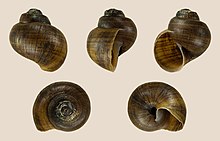 | |||
| Melanoides[2] | M. tuberculata |  | |||
| Mutela[2] | M. sp. | 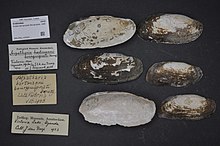 | |||
| Pleiodon[2] | P. sp. |  |
Annelids
| Name | Species | Member | Material | Notes | Image |
|---|---|---|---|---|---|
| Annelidae indet.[2] | Member C
Member D Member E |
Arthropods
| Name | Species | Member | Material | Notes | Image |
|---|---|---|---|---|---|
| Candona[2] | C. sp. | ||||
| Coleoptera indet.[2] | |||||
| Diptera indet.[2] | |||||
| Heterocypris?[2] | H. sp.? | ||||
| Isoptera indet.[2] | |||||
| Lepidoptera indet.[2] | |||||
| Limnicythere[2] | L. sp. | ||||
| Metacypris[2] | M. sp. | ||||
| Potamon[2] | C. sp. |
Fish
| Name | Species | Member | Material | Notes | Image |
|---|---|---|---|---|---|
| cf. Clarias[2] | cf. C. sp. | Member D
Member E |
|||
| Cyprinidae indet.[2] | Member C | ||||
| Baringochromis [6] | B. senutae | Member E | more than a dozen skeletons | species flock of haplochromine cichlids | |
| B. sonyii | Member E | five skeletons | |||
| B. tallamae | Member E | several skeletons | |||
| Oreochromis[4] | O. martyni | Member C | also known as "Sarotherodon" martyni, inhabitant of an alkaline lake | ||
| Oreochromimos[7] | O. kabchorensis | Member C | several complete skeletons | oldest known member of the Oreochromini | |
| Rebekkachromis[8] | P. kiptalami | Member D | a nearly complete skeleton | pseudocrenilabrine cichlid likely inhabiting alkaline lakes, possible species flock | |
| P. ngororus | Member D | a nearly complete skeleton | |||
| P. valyricus | Member C | a skeleton | |||
| P. vancouveringae | Member C | a skeleton | |||
| P. spp. | Member A
Member C |
a skeleton | |||
| Tugenchromis[9] | T. pickfordi | Member E | partially complete skeleton | pseudocrenilabrine cichlid | |
| Warilochromis[10] | W. unicuspidatus | Member E | a single skeleton | pseudocrenilabrine cichlid |
Reptiles
| Name | Species | Member | Material | Notes | Image |
|---|---|---|---|---|---|
| Crocodylus[2] | C. sp. | Member A
Member B Member C Member D Member E |
 | ||
| Ophidia indet.[2] | |||||
| Pelusios[2] | P. cf. sinuatus | Member A
Member B Member E |
 | ||
| Testudo[2] | T. sp. | Member D | |||
| Trionyx[2] | T. sp. | Member B
Member D Member E |
|||
| Varanidae indet. | Member B[2]
Member D |
Birds
| Name | Species | Member | Material | Notes | Image |
|---|---|---|---|---|---|
| Anhinga[11] | A. cf. pannonica | proximal end of the humerus | |||
| Leptoptilos[12] | L. sp. | Member C | a partial skeleton composed mostly of limb bones | one of the oldest known marabou skeletons |  |
| Struthio[13] | S. sp. | Member C | limb bones | distinct from the roughly contemporary S. coppensi |
Mammals
Afrotheres
Hyraxes
| Name | Species | Member | Material | Notes | Image |
|---|---|---|---|---|---|
| Parapliohyrax[14] | P. ngororaensis | Member B
Member C Member D Member E |
57 specimens, including isolated teeth, mandibles and crania | a type of hyrax |
Macroscelidea
| Name | Species | Member | Material | Notes | Image |
|---|---|---|---|---|---|
| Macroscelididae indet.[2] | an indetermined elephant shrew |
Orycteropodidae
| Name | Species | Member | Material | Notes | Image |
|---|---|---|---|---|---|
| Myorycteropus [15] | M. chemeldoi | Member B | a type of aardvark |
Proboscideans
| Name | Species | Member | Material | Notes | Image |
|---|---|---|---|---|---|
| Afrochoerodon[16] | A. ngorora | Member A
Member D Member E |
a choerolophodontine gomphothere. | ||
| Choerolophodon[17] | C. ngorora | Member A | Partial skeleton and maxillary fragments | A choerolophodontine gomphothere. |  |
| Deinotherium[2] | D. bozasi | Member D |  | ||
| Zygolophodon[18] | Z. turicensis | Member A |
Ptolemaiidae
| Name | Species | Member | Material | Notes | Image |
|---|---|---|---|---|---|
| Kelba[19] | K. quadeemae | A single lower molar and post cranial. | The most recent Ptolemaiidae known |
Artiodactyls
| Name | Species | Member | Material | Notes | Image |
|---|---|---|---|---|---|
| Afrikanokeryx[20] | A. leakeyi | Braincase with the posterior ossicones, associated with a left mandible. | Closely related to the modern Okapi | ||
| Albanohyus[21] | A. cf. castellensis | skull without teeth | a possible ancestor of Cainochoerus | ||
| Anthracotheriidae indet.[15] | |||||
| Climacoceras[15] | C. gentryi | a giraffid |  | ||
| Cephalophini? indet.[2] | an indetermined species of duiker | ||||
| Dorcatherium [15] | D. sp. | a genus of mouse deer |  | ||
| Gazella[2] | G. sp. | ||||
| Gentrytragus [22] | G. gentryi | Formerly assigned to Pseudotragus. | |||
| Homoiodorcas[23] | H. tugenicum | ||||
| Kenyapotamus [24][25][26] | K. coryndonae | Member D Member E | molars | the possible ancestor of the modern hippos | |
| Kipsigicerus[23] | K. labidotus | a close relative of the Four-horned antelope | 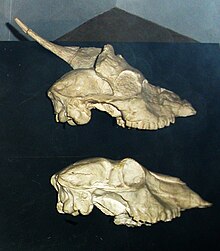 | ||
| Lagomerycidae indet.[2] | |||||
| Listriodon[27] | L. bartulensis | Member A | mandible and teeth | the molars of this species are notably smaller than that of Eurasian taxa |  |
| Lopholistriodon[27] | L. kidogosana | Member B
Member C Member D |
skull and teeth as well as a fragment of a mandibular symphysis | Lopholistriodon marks another decrease in size within the African listriodontine lineage | |
| Morotochoerus [22] | M. ugandensis | ||||
| Palaeotragus[20] | P. sp. | Remains attributed to P. primaevus have been assigned to a new genus and species, Afrikanokeryx leakeyi. |  | ||
| Protoryx[23][22] | P. solignaci | Remains from Ngorora might belong to an indeterminate reduncine. | |||
| Pseudotragus?[15] | P.? gentryi | ||||
| ?Reduncini indet.[22] | Several indeterminate species | Include some remains formerly attributed to the genera Antidorcas and Pachytragus. Some of the horn cores might belong to Kobus aff. porrecticornis. | |||
| Samotherium?[2] | S. sp. | a genus of giraffid | 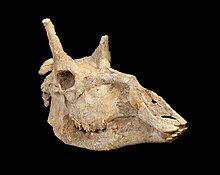 | ||
| Sivoreas[28] | S. eremita | Member A
Member C Member D |
horn cores | a boselaphine bovid | |
| Tetraconodontinae[29] | Indetermidate. | Perhaps belonging to a species more primitive than Nyanzachoerus |
Carnivorans and Hyaenodonts
| Name | Species | Member | Material | Notes | Image |
|---|---|---|---|---|---|
| Amphicyonidae indet.[30] | molar | ||||
| Dissopsalis[31] | D. pyroclasticus | an incomplete first or second molar | A genus of teratodontine hyaenodontid. | ||
| Eomellivora[32] | E. tugenensis | Member D | a broken snout | a relative of the modern honey badger of similar size | 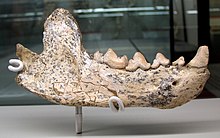 |
| Herpestidae[32] | Indeterminate. | Member A | a right mandible | an indetermined mongoose | |
| Megistotherium[32] | M. osteothlastes | Member A
Member D |
a damaged molar and distal end of a humerus | A large hypercarnivorous hyaenodont. | 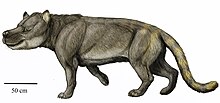 |
| Myacyon[33] | M. kiptalami | Member D | a snout broken behind the second molar | a species as large or slightly larger than an African Lion, originally considered to belong to the genus Agnotherium[32] | |
| Percrocuta [32] | P. tobieni | Member B
Member D Member E |
a left mandible fragment | a lioness-sized genus of percrocutids or true hyaenas | |
| Tugenictis[32] | T. ngororaensis | Member A | a right molar | a genus of viverrid similar in size to the African Civet | |
| Vishnuonyx[32] | V. chinjiensis | Member D | a premolar | a genus of otter | |
| Viverridae indet.[32] | Member B | a mandible with fragments of the premolars | the morphology resembles the genus Genetta more than it does Viverra and is slightly larger |
Perissodactyls
Equids
| Name | Species | Member | Material | Notes | Image |
|---|---|---|---|---|---|
| Hipparion[1] | H. sp. | Member E | tooth fragments and other remains | dated to 11 to 10.5 Ma, the fossils at Ngorora indicate a rapid dispersal of the genus throughout Africa and Eurasia |  |
Rhinocerotids
| Name | Species | Member | Material | Notes | Image |
|---|---|---|---|---|---|
| Aceratherium[2] | A. acutirostratum | A hornless rhinoceros, originally attributed to a new genus, Turkanatherium. | |||
| Brachypotherium[34] | B. sp. | although the genus was reported, no detailed description or figures were given, rendering a more detailed assignment not possible | |||
| Chilotheridium[35] | C. sp. | Member E | a maxillary fragment including several teeth | originally described as C. pattersoni, subsequent research showed the fossil is not well preserved enough for such an assignment |
Primates
| Name | Species | Member | Material | Notes | Image |
|---|---|---|---|---|---|
| Catarrhini indet. | canine | possible hominoid clearly distinct from Proconsul[15] | |||
| Hominoidea indet. | Member C | incisor and premolar | a large hominoid similar to Proconsul or Equatorius[15] | ||
| Microcolobus | M. tugenensis | a colombine monkey. | |||
| Victoriapithecus | V. sp. | Member B
Member C |
various teeth | possibly a new species of the genus[15] | 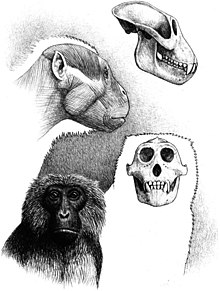 |
Rodents
| Name | Species | Member | Material | Notes | Image |
|---|---|---|---|---|---|
| Bathyergidae indet.[36] | |||||
| Cricetidae indet. A[2] | |||||
| Cricetidae indet. B[2] | |||||
| Cricetomyinae indet.[36] | |||||
| Dendromurinae indet.[2] | |||||
| Pedetidae?[2] | Member B | ||||
| Phiomyidae[2] | |||||
| cf. Vulcanisciurus[37] | cf. Vulcanisciurus sp. | A genus of squirrel. |
Paleoflora
| Name | Species | Member | Material | Notes | Image |
|---|---|---|---|---|---|
| Acalypha[5] | A. sp. | a type of herb/shrub |  | ||
| Acanthaceae[5] | |||||
| Artabotrys[5] | A. sp. | a type of shrub |  | ||
| Bignoniaceae[5] | |||||
| cf. Cola[5] | cf. C. sp. | a species of the tree canopy | 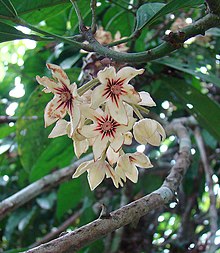 | ||
| Dioscorea[5] | D. sp. | a liana |  | ||
| Graminae[5] | a type of grass | ||||
| Icacinaceae[5] | |||||
| Lasiodiscus[5] | L. sp. | an understory taxon | 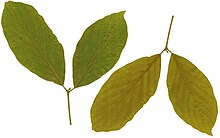 | ||
| Loganiaceae/Melastomataceae[5] | |||||
| Menispermaceae[5] | |||||
| Myrtaceae[5] | |||||
| Mystroxylon[5] | M. sp. | a type of shrub/tree |  | ||
| Olacaceae[5] | |||||
| Pollia | P. tugenensis[38] | stems, leaves and fruit | a dominant plant of the herbaceous layer, Pollia tugenensis likely grew in clusters |  | |
| Rauvolfia[5] | R. sp. | a tree or shrub |  | ||
| Rubiaceae[5] | |||||
| Rutaceae[5] | |||||
| Sapindaceae[5] | |||||
| cf. Sapium[5] | cf. S. sp. | a type of milkree | 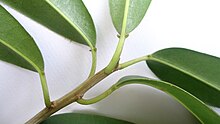 | ||
| cf. Sapotaceae[5] | |||||
| Tiliaceae[5] | |||||
| Violaceae[5] | |||||
| cf. Zizyphus[5] | cf. Z. sp. | a spiny shrub/tree of the buckthorn family |  |
References
- ^ a b c Pickford, H.M.L. (2001). "Equidae in the Ngorora Formation, Kenya, and the first appearance of the family in East Africa". Spanish Journal of Palaeontology. 16 (2): 339–345. ISSN 0213-6937.
- ^ a b c d e f g h i j k l m n o p q r s t u v w x y z aa ab ac ad ae af ag ah ai aj ak al am an Bishop, W.W.; Pickford, M.H.L. (1975). "Geology, fauna and paleoenvironments of the Ngorora Formation, Kenya Rift Valley". Nature. 254 (5497): 185–192. Bibcode:1975Natur.254..185B. doi:10.1038/254185a0. S2CID 4224993.
- ^ Bishop, W.W.; Chapman, G.R. (1970). "Early Pliocene Sediments and Fossils from the Northern Kenya Rift Valley". Nature. 226 (5249): 914–918. Bibcode:1970Natur.226..914B. doi:10.1038/226914a0. PMID 16057593. S2CID 4289662.
- ^ a b Rasmussen, Cornelia; Reichenbacher, Bettina; Lenz, Olaf; Altner, Melanie; Penk, Stefanie B. R.; Prieto, Jerome; Brüsch, Dennis (2017). "Middle–late Miocene palaeoenvironments, palynological data and a fossil fish Lagerstätte from the Central Kenya Rift (East Africa)". Geological Magazine. 154 (1): 24–56. Bibcode:2017GeoM..154...24R. doi:10.1017/S0016756815000849. ISSN 0016-7568. S2CID 130521301.
- ^ a b c d e f g h i j k l m n o p q r s t u v w x Jacobs, B.F.; Winkler, D.A. (1992). "Taphonomy of a middle Miocene autochthonous forest assemblage, Ngorora Formation, central Kenya". Palaeogeography, Palaeoclimatology, Palaeoecology. 99 (1–2): 31–40. Bibcode:1992PPP....99...31J. doi:10.1016/0031-0182(92)90005-P.
- ^ Altner, Melanie; Reichenbacher, Bettina (2021-09-01). "A small cichlid species flock from the Upper Miocene (9–10 MYA) of Central Kenya" (PDF). Hydrobiologia. 848 (16): 3613–3637. doi:10.1007/s10750-020-04358-z. ISSN 1573-5117. S2CID 221145584.
- ^ Penk, Stefanie B. R.; Altner, Melanie; F. Cerwenka, Alexander; Schliewen, Ulrich K.; Reichenbacher, Bettina (2019-07-15). "New fossil cichlid from the middle Miocene of East Africa revealed as oldest known member of the Oreochromini". Scientific Reports. 9 (1): 10198. Bibcode:2019NatSR...910198P. doi:10.1038/s41598-019-46392-5. ISSN 2045-2322. PMC 6629881. PMID 31308387. S2CID 256997522.
- ^ Kevrekidis, Charalampos; Ruthensteiner, Bernhard; Cerwenka, Alexander F.; Penk, Stefanie B. R.; Reichenbacher, Bettina (2020-07-03). "New Cichlid Fossils from the Middle-Late Miocene Alkaline Lakes of Africa". Journal of Vertebrate Paleontology. 40 (4): e1805621. Bibcode:2020JVPal..40E5621K. doi:10.1080/02724634.2020.1805621. ISSN 0272-4634. S2CID 224855992.
- ^ Altner, Melanie; Schliewen, Ulrich K.; Penk, Stefanie B. R.; Reichenbacher, Bettina (2017-03-04). "†Tugenchromis pickfordi, gen. et sp. nov., from the upper Miocene—a stem-group cichlid of the 'East African Radiation'". Journal of Vertebrate Paleontology. 37 (2): e1297819. Bibcode:2017JVPal..37E7819A. doi:10.1080/02724634.2017.1297819. ISSN 0272-4634. S2CID 90864709.
- ^ Altner, Melanie; Ruthensteiner, Bernhard; Reichenbacher, Bettina (2020-06-05). "New haplochromine cichlid from the upper Miocene (9–10 MYA) of Central Kenya". BMC Evolutionary Biology. 20 (1): 65. Bibcode:2020BMCEE..20...65A. doi:10.1186/s12862-020-01602-x. ISSN 1471-2148. PMC 7275555. PMID 32503417.
- ^ Dyke, G.J.; Walker, C.A. (2008). "New Records of Fossil 'Waterbirds' from the Miocene of Kenya". American Museum Novitates (3610): 1–10. doi:10.1206/0003-0082(2008)3610[1:NROFWF]2.0.CO;2. hdl:2246/5906. S2CID 53518113.
- ^ Walker, A.; Hill, A. (1978). "A fossil marabou (Aves: Ciconiidae) from the Miocene Ngorora formation, Baringo district, Kenya". Netherlands Journal of Zoology. 29 (2): 215–221. doi:10.1163/002829679X00287.
- ^ Leonard, L.M.; Dyke, G.J.; Walker, C.A. (2006). "New specimens of a fossil ostrich from the Miocene of Kenya". Journal of African Earth Sciences. 45 (4–5): 391–394. Bibcode:2006JAfES..45..391L. doi:10.1016/j.jafrearsci.2006.03.007.
- ^ Pickford, M. (1987). "Parapliohyrax ngororaensis, a new hyracoid from the Miocene of Kenya, with an outline of the classification of Neogene Hyracoidea". Neues Jahrbuch für Geologie und Paläontologie. 175 (2): 207–234. doi:10.1127/njgpa/175/1987/207.
- ^ a b c d e f g h Hill, A.; Leakey, M.; Kingston, J.D.; Ward, S. (2002). "New cercopithecoids and a hominoid from 12.5 Ma in the Tugen Hills succession, Kenya". Journal of Human Evolution. 42 (1–2): 75–93. doi:10.1006/jhev.2001.0518. PMID 11795969.
- ^ Pickford, M. (2001). "Afrochoerodon nov. gen. kisumuensis (MacInnes) (Proboscidea, Mammalia) from Cheparawa, Middle Miocene, Kenya". Annales de Paléontologie. 87 (2): 99–117. Bibcode:2001AnPal..87...99P. doi:10.1016/S0753-3969(01)80005-7.
- ^ MAGLIO, V. J. 1974. A new proboscidean from the late Miocene of Kenya. Palaeontology, 17, 3, 699–705.
- ^ Sanders, W.J.; Gheerbrant, E.; Harris, J. M.; Saegusa, H.; Delmer, C. (2010). "Fifteen: Proboscidea". In Werdelin, L. (ed.). Cenozoic Mammals of Africa. University of California Press. pp. 161–251. doi:10.1525/california/9780520257214.003.0015. ISBN 9780520945425.
- ^ Cote, S.; Werdelin, E.; Seiffert, E. R.; Barry, J. C. (2007). "Additional material of the enigmatic Early Miocene mammal Kelba and its relationship to the order Ptolemaiida". Proceedings of the National Academy of Sciences of the United States of America. 104 (13): 5510–5515. Bibcode:2007PNAS..104.5510C. doi:10.1073/pnas.0700441104. PMC 1838468. PMID 17372202.
- ^ a b Harris, J.M.; Solounias, N.; Geraads, D. (2010). "Thirty-Nine: Giraffoidea". In Werdelin, L. (ed.). Cenozoic Mammals of Africa. University of California Press. pp. 123–145. doi:10.1525/california/9780520257214.003.0039. ISBN 9780520945425.
- ^ Van Der Made, J. (1996). "Albanohyus, a small Miocene pig". Acta Zoologica Cracoviensia. 39 (1): 293–303.
- ^ a b c d Gentry, A. W. (2010). "Thirty-Eight: Bovidae". In Werdelin, L. (ed.). Cenozoic Mammals of Africa. University of California Press. pp. 741–796. doi:10.1525/california/9780520257214.003.0038. ISBN 9780520945425.
- ^ a b c Kauffman, E.G.; Walliser, O.H. (1990). "Mammal extinctions in the Vallesian (Upper Miocene)". Extinction Events in Earth History. Lecture Notes in Earth Sciences. Vol. 30. pp. 425–432. doi:10.1007/bfb0011163. ISBN 3-540-52605-6.
- ^ Boisserie, J.-R.; Lihoreau, F.; Orliac, M.; Fisher, R.E.; Weston, E.M.; Ducrocq, S. (2010). "Morphology and phylogenetic relationships of the earliest known hippopotamids (Cetartiodactyla, Hippopotamidae, Kenyapotaminae)". Zoological Journal of the Linnean Society. 158 (2): 325–366. doi:10.1111/j.1096-3642.2009.00548.x.
- ^ Pickford, M. (2011). "Morotochoerusfrom Uganda (17.5 Ma) andKenyapotamusfrom Kenya (13-11 Ma): implicationsfor hippopotamid origins". Estudios Geológicos. 67 (2). doi:10.3989/egeol.40393.205. ISSN 0367-0449.
- ^ Weston, E.; Boisserie, J.-R. (2010). "Forty-Four: Hippopotamidae". In Werdelin, L. (ed.). Cenozoic Mammals of Africa. University of California Press. pp. 123–145. doi:10.1525/california/9780520257214.003.0044. ISBN 9780520945425.
- ^ a b Pickford, M. (2001). "New species of Listriodon (Suidae, Mammalia) from Bartule, Member A, Ngorora Formation (ca 13 Ma), Tugen Hills, Kenya". Annales de Paléontologie. 87 (3): 207–221. Bibcode:2001AnPal..87..207P. doi:10.1016/S0753-3969(01)80010-0.
- ^ Van Der Made, J.; Hussain, S.T. (1994). "Horn cores of Sivoreas (Bovidae) from the Miocene of Pakistan and utility of their torsion as a taxonomic tool". Geobios. 27 (1): 103–111. Bibcode:1994Geobi..27..103V. doi:10.1016/S0016-6995(06)80218-4.
- ^ Bishop, L.C. (2010). "Forty-Two: Suoideadoi=10.1525/california/9780520257214.003.0042". In Werdelin, L. (ed.). Cenozoic Mammals of Africa. University of California Press. pp. 821–842. doi:10.1525/california/9780520257214.003.0042. ISBN 9780520945425.
- ^ Morales, J.; Brewer, P.; Pickford, M.H.L. (2010). "CARNIVORES (CREODONTA AND CARNIVORA) FROM THE BASAL MIDDLE MIOCENE OF GEBEL ZELTEN, LIBYA, WITH A NOTE ON A LARGE AMPHICYONID FROM THE MIDDLE MIOCENE OF NGORORA, KENYA". Bulletin of the Tethys Geological Society, Cairo. 5: 43–54.
- ^ Barry, J.C. (1988). "Dissopsalis, a middle and late Miocene proviverrine creodont (Mammalia) from Pakistan and Kenya". Journal of Vertebrate Paleontology. 8 (1): 25–45. Bibcode:1988JVPal...8...25B. doi:10.1080/02724634.1988.10011682.
- ^ a b c d e f g h Morales, J.; Pickford, M.H.L. (2005). "Carnivores from the Middle Miocene Ngorora Formation (13-12 Ma), Kenya". Estudios Geológicos. 61 (3). doi:10.3989/egeol.05613-668.
- ^ MORALES J., PICKFORD M. & VALENCIANO A. 2016. — Systematics of African Amphicyonidae, with descriptions of new material from Napak (Uganda) and Grillental (Namibia). Journal of Iberian Geology 42 (2): 131-150. http://hdl.handle.net/10261/137042
- ^ Handa, N.; Nakatsukasa, M.; Kunimatsu, Y.; Nakaya, H. (2018). "Brachypotherium (Perissodactyla, Rhinocerotidae) from the late Miocene of Samburu Hills, Kenya". Geobios. 51 (5): 391–399. Bibcode:2018Geobi..51..391H. doi:10.1016/j.geobios.2018.08.003. S2CID 135048457.
- ^ Handa, N.; Nakatsukasa, M.; Kunimatsu, Y.; Tsubamoto, T.; Nakaya, H. (2015). "New specimens of Chilotheridium (Perissodactyla, Rhinocerotidae) from the Upper Miocene Namurungule and Nakali Formations, northern Kenya". Paleontological Research. 19 (3): 181–194. doi:10.2517/2014PR035. S2CID 130817602.
- ^ a b Winkler, A. J.; Denys, C.; Avery, M. (2010). "Seventeen: Rodentia". In Werdelin, L. (ed.). Cenozoic Mammals of Africa. University of California Press. pp. 262–304. doi:10.1525/california/9780520257214.003.0017. ISBN 9780520945425.
- ^ Winkler, A. J. (1992). "Systematics and biogeography of middle Miocene rodents from the Muruyur Beds, Baringo District, Kenya". Journal of Vertebrate Paleontology. 12 (2): 236–249. Bibcode:1992JVPal..12..236W. doi:10.1080/02724634.1992.10011453.
- ^ Jacobs, B.F.; Kabuye, C.H.S. (1989). "An extinct species of Pollia Thunberg (Commelinaceae) from the Miocene Ngorora Formation, Kenya". Review of Palaeobotany and Palynology. 59 (1–4): 67–76. Bibcode:1989RPaPa..59...67J. doi:10.1016/0034-6667(89)90007-9.

